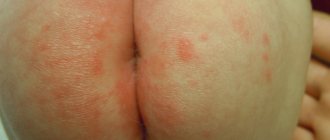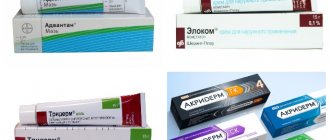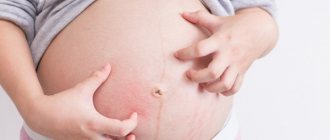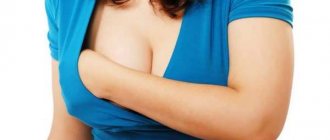Allergic urticaria
The child is prescribed a hypoallergenic diet according to A.D.
Ado. Food allergens to which the body reacts and histamine-releasing products should be excluded from the diet. The medications prescribed depend on how severe the child's hives are. In case of exacerbation of severe urticaria, take some of the following medications (as prescribed by a doctor):
- clemastine
— chloropyramine 2.5% (course 5-7 days)
- systemic glucocorticosteroids (if the above drugs were ineffective): dexamethasone, prednisolone
- according to indications, hemodez 200-400 ml intravenously, 3-4 injections
- fexofenadine (Telfast)
- loratadine (Claritin) once a day
- ketotifen
For the treatment of exacerbations of moderate urticaria, take:
— clemastine (tavegil) 0.1%
— chloropyramine (suprastin) 2.5%
— systemic glucocorticosteroids (according to indications)
- fexofenadine
- loratadine
- ketotifen (zaditen) 0.001 g 2 times a day
In case of mild exacerbations of urticaria, elimination measures are carried out. Glucocorticosteroids are not used. Then fexofenadine (Telfast) and loratadine are used once a day. Course – 1 month. Ketotifen is taken for a course of 3 months.
Treatment in a hospital is 18-20 days. If necessary, SIT and a course of histaglobulin are carried out in an allergy hospital or office.
How to distinguish heat rash from allergies in a child
An itchy rash, extensive redness on the skin, whiteheads on the face, small pimples on the body - babies are prone to diathesis and various rashes. How to distinguish heat rash from allergies in a baby just by examining the skin? Together with pediatrician Polina Aleksandrovna Kizino, we will learn to identify different types of rashes in babies in order to respond to them as quickly as possible and protect the health of your baby. But home diagnostics are not enough - in the article we will also talk about treatment options for rashes in children and situations that require a doctor’s assessment.
— Polina Aleksandrovna, rashes in newborns and infants are widespread, and it can be quite difficult to distinguish one type of skin rash from another. Miliaria and allergies in infants - what is the fundamental difference and how do they affect health?
Allergic rash
- manifestation of a pathological reaction to food, which is based on immune mechanisms. They are different and can be combined, but, in essence, the body reacts to the ingestion of a food allergen.
Miliaria in newborns
- skin irritation, which is associated with the functioning of the sweat glands. When increased sweating and slow evaporation of moisture from the surface of the skin occurs, the sweat glands become clogged and cannot empty - a rash appears.
Allergy or prickly heat: how to determine
Causes of allergies
| Features of the manifestation of allergic rashes The skin has areas of redness, dryness and excessive peeling:
Hives are hardened areas of skin that hang over healthy skin like blisters. These manifestations:
| How to help your child with food allergies
|
What causes clogged sweat glands?
| Types of prickly heat in infants and features of prickly heat rash Miliaria rubra
Pupulous miliaria
Crystal prickly heat
| How to get rid of prickly heat in a child
|
Miliaria or allergies in infants - what to treat
— Polina Aleksandrovna, we discussed how and where prickly heat/allergies most often manifest themselves. Let's now talk about the treatment of these diseases. How can they be resisted?
Food allergies
- It is almost impossible to cure allergies, but remission can be achieved if the child does not come into contact with allergens.
- If you have isolated reactions, you don’t have to worry, but if there are severe rashes that bother your child, you should consult a doctor.
Prickly heat
- No special treatment is required, just adequate hygiene is required.
- It is necessary to consult a doctor to differentiate prickly heat from an infectious rash and to care for the child, being sure that “bad” diseases have not been missed.
— How are children with allergies usually treated? Where does treatment begin and what do parents need to prepare for?
— If the allergy is in an acute phase and the skin rashes are very pronounced, and the child is worried, the doctor may prescribe antiallergic drugs that will conditionally extinguish the reaction and relieve external manifestations. Parents need to be prepared to analyze their child's diet to identify the allergen and then prevent the child from exposing that allergen.
Depending on the severity of the reaction, the nature of the clinical manifestations and the number of identified allergens, on the advice of a doctor at a certain time, it will be possible to reintroduce allergenic foods into the diet in microdoses and monitor the child’s reaction to them.
- If the child no longer reacts to the allergen, food restrictions become less strict and may then be lifted completely.
- In case of recurrence of allergic reactions, the diet is maintained for life. But in any case, you can live with it. Even in kindergartens and schools, the characteristics of little allergy sufferers are taken into account, and food intolerance does not in any way affect their quality of life.
— How to treat prickly heat in a newborn with folk remedies: what is effective and what only masks the problem?
— I do not recommend using folk remedies, since their effectiveness in blocking the sweat glands is unproven. It is enough to carry out hygiene procedures and prevent even more severe clogging of the ducts.
- Bathing in antiseptics
is not very beneficial for the skin. Antiseptics are very drying and kill all flora, including normal flora, which is a protective factor of the skin. Without it, pathogenic flora can spread and lead to inflammation and rash. - Herbal infusions
are a natural product of plant origin, but you cannot be sure that it will not lead to an allergic reaction. Allergies to herbs develop quite often, and it is better not to risk it.
— What will happen if you treat allergies with prickly heat medications or prickly heat with allergy medications?
— Antihistamines for prickly heat will not work, because this condition has a different, non-allergic etiology. If a mother mistakes an allergy for heat rash, she simply cannot trace the connection between skin manifestations and the consumption of certain products - accordingly, the allergen will not be removed from the child’s diet in time and will continue to fuel the allergic reaction. It will only get worse. Therefore, it is better not to self-medicate and make sure at a doctor’s appointment that the child actually has heat rash or an allergy.
Idiopathic urticaria
To treat this type of urticaria, the child must follow a hypoallergenic diet according to A.D. Ado. The same medications are recommended as for the treatment of exacerbations of moderate urticaria. In case of torpidity, the child may be prescribed long-acting glucocorticosteroids for a course of 2-3 weeks to symptomatic therapy.
Detoxification therapy involves the administration of hemodez 400 mg and the intake of sorbents. The child is prescribed digestive enzymes, for example, mezim or festal, but not in all cases. Based on the identified pathology, the child is prescribed symptomatic treatment: antifungal, antibacterial, etc.
If treatment with antihistamines is effective, then a course of histaglobulin follows.
Nursing care for urticaria
Before medical help arrives, you need to:
- put the baby on his back;
- place your legs above the horizontal surface;
- open your mouth slightly to avoid sticking your tongue and swallowing possible vomit;
- provide the patient with fresh air.
In case of cardiac arrest, perform resuscitation actions on your own: indirect massage of a vital organ, mouth-to-mouth artificial respiration.
The protocol for providing emergency care by a nurse involves the following algorithm of action:
- stop contact with the allergen;
- guarantee physical and psychological comfort;
- prepare the necessary instruments, establish the possibility of acceptable IV administration of the drug;
- inject the child or give him to drink (depending on the severity) an antihistamine (Suprastin, Claritin);
- perform treatment with enterosorbents;
- if there are no favorable dynamics, administer Prednisolone 3% 1-2 mg/kg intramuscularly;
- for anaphylaxis - administration of Adrenaline.
If you experience a food allergic reaction, the symptoms of which quickly increase, you need to rinse the stomach by artificially induced vomiting. But this action is carried out only in the absence of swelling of the throat, otherwise aspiration of vomit is possible.
Temperature urticaria
As with the types of urticaria described above, the child follows a diet according to A.D. Ado. You should adhere to a gentle thermal regime, avoiding high and too low temperatures. If the effect of thermal factors on the body is inevitable, antihistamines should be taken before contact. In cases of photodermatosis, photosensitizing drugs are discontinued.
For the generalized form, take clemastine 0.1% 2 ml, chloropyramine (suprastin) 2.5%, dexamethasone, prednisone. For mild to moderate cases, take fexofenadine and loratadine once a day. Doctors may also prescribe antihistamines with a stabilizing effect on mast cell membranes.
Urticaria in children
Acute urticaria in children is characterized by the sudden appearance of intensely itchy spots and blisters of pale pink color on the skin, most often affecting the torso, arms and buttocks. Blisters are rounded formations rising above the surface of the skin with a matte tint and a rim of hyperemia; they can merge into fairly large areas.
Skin changes may be accompanied by a disturbance in the general condition: chills, fever (nettle fever), headache, vomiting, diarrhea. Damage to the mucous membranes of the oral cavity, nasopharynx and larynx is rarely observed. The primary urticarial rash does not last long, from a few minutes to 1-2 hours and disappears without the formation of secondary elements, but new rashes may appear. With dermographic acute urticaria in children, itching is often absent.
Giant urticaria or acute angioedema (Quincke's edema) in children is expressed by a sharp development of local swelling of the skin, mucous membrane and subcutaneous fat (often in the area of the lips, eyes, genitals). When the swelling is localized in the larynx, a state of suffocation may occur. Quincke's edema in children can be combined with normal urticaria and has a tendency to recur.
Chronic urticaria develops with prolonged sensitization and is characterized by a paroxysmal course and less abundant rashes. Weakness, low-grade fever, headache, arthralgia, and sometimes nausea and diarrhea are noted. Excruciating itching (especially in the evening and at night) can lead to neurotic disorders. Long-lasting urticarial elements of the rash can progress to the stage of papules (red-brown nodules) with the development of papular urticaria in children, accompanied by hyperkeratosis and acanthosis.
Cold urticaria in children appears within a few minutes after exposure to cold or immediately after warming the cooled skin, and when large areas of the skin are affected, it can be combined with anaphylactoid (pseudoallergic) reactions. Eating cold foods (ice cream, cold water, chilled fruit) may be accompanied by oropharyngeal edema and gastrointestinal symptoms.
Solar urticaria in children is characterized by urticarial rashes, itching, erythema on open areas of the skin of the face and upper extremities from the first minutes of insolation. Respiratory disturbances (bronchospasm), cardiac activity, arterial hypotension, and sometimes a state of shock are possible.
Papular urticaria in children manifests itself as small blisters at the site of an insect bite and can persist for more than 24 hours; With repeated bites, systemic allergic reactions may develop. With serum sickness, urticaria in children is accompanied by fever, swollen lymph nodes, and joint pain.









